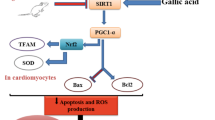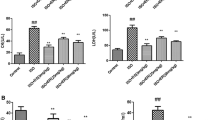Abstract
Phytanic acid (Phyt) accumulates in tissues and biological fluids of patients affected by Refsum disease. Although cardiomyopathy is an important clinical manifestation of this disorder, the mechanisms of heart damage are poorly known. In the present study, we investigated the in vitro effects of Phyt on important parameters of oxidative stress in heart of young rats. Phyt significantly increased thiobarbituric acid-reactive substances levels (P < 0.001) and carbonyl formation (P < 0.01), indicating that this fatty acid induces lipid and protein oxidative damage, respectively. In contrast, Phyt did not alter sulfhydryl oxidation. Phyt also decreased glutathione (GSH) concentrations (P < 0.05), an important non-enzymatic antioxidant defense. Moreover, Phyt increased 2′,7′-dichlorofluorescin oxidation (DCFH) (P < 0.01), reflecting increased reactive species generation. We also found that the induced lipid and protein oxidative damage, as well as the decreased GSH levels and increased DCFH oxidation provoked by this fatty acid were prevented or attenuated by the reactive oxygen species scavengers melatonin, trolox, and GSH, but not by the nitric oxide inhibitor n ω-nitro-l-arginine methyl ester, suggesting that reactive oxygen species were involved in these effects. Next, we verified that Phyt strongly inhibited NADH-cytochrome c oxidoreductase (complex I–III) activity (P < 0.001) in heart supernatants, and decreased membrane potential and the NAD(P)H pool in heart mitochondria, indicating that Phyt acts as a metabolic inhibitor and as an uncoupler of the electron transport chain. Therefore, it can be presumed that disturbance of cellular energy and redox homeostasis induced by Phyt may possibly contribute to the cardiomyopathy found in patients affected by Refsum disease.







Similar content being viewed by others
References
Verhoeven NM, Jakobs C (2001) Human metabolism of phytanic and pristanic acid. Progr Lipid Res 40:453–466. doi:10.1016/S0163-7827(01)00011-X
Brosius U, Gärtner J (2002) Cellular and molecular aspects of Zellweger syndrome and other peroxisome biogenesis disorders. Cell Mol Life Sci 59:1058–1069
Gould SJ, Raymond GV, Valle D (2001) The peroxisome biogenesis disorders. In: Scriver CR, Beaudet AL, Valle D (eds) The metabolic and molecular bases of inherited disease. McGraw-Hill, New York, pp 3181–3217
Wanders RJ, Schutgens RB, Barth PG, Tager JM, van den Bosch H (1993) Postnatal diagnosis of peroxisomal disorders: a biochemical approach. Biochimie 75:269–279. doi:10.1016/0300-9084(93)90087-9
Al-Dirbashi OY, Santa T, Rashed MS, Al-Hassnan Z, Shimozawa N, Chedrawi A, Jacob M, Al-Mokhadab M (2008) Rapid UPLC-MS/MS method for routine analysis of plasma pristanic, phytanic, and very long chain fatty acid markers of peroxisomal disorders. J Lipid Res 49(8):1855–1862. doi:10.1194/jlr.D800019-JLR200
Mönnig G, Wiekowski J, Kirchhof P, Stypmann J, Plenz G, Fabritz L, Bruns HJ, Eckardt L, Assmann G, Haverkamp W, Breithardt G, Seedorf U (2004) Phytanic acid accumulation is associated with conduction delay and sudden cardiac death in sterol carrier protein-2/sterol carrier protein-x deficient mice. J Cardiovasc Electrophysiol 15(11):1310–1316. doi:10.1046/j.1540-8167.2004.03679.x
Wanders RJA, Waterham HR, Leroy BP (2006) Refsum disease. In: Pagon RA, Bird TD, Dolan CR, Stephens K (eds) GeneReviews [Internet]. University of Washington, Seattle
Wanders RJ, Jakobs C, Skjeldal OH (2001) Refsum disease. In: Scriver CR, Beaudet AL, Sly WS, Valle D (eds) The metabolic and molecular bases of inherited disease. McGraw-Hill, New York, pp 3303–3322
Weinstein R (1999) Phytanic acid storage disease (Refsum’s disease): clinical characteristics, pathophysiology and the role of therapeutic apheresis in its management. J Clin Apher 14:181–184. doi:10.1002/(SICI)1098-1101(1999)14:4<181:AID-JCA5>3.0.CO;2-Z
Wierzbicki AS (2007) Peroxisomal disorders affecting phytanic acid α-oxidation: a review. Biochem Soc Trans 35(5):881–886
Koh JT, Choi HH, Ahn KY, Kim JU, Kim JH, Chun JY, Baik YH, Kim KK (2001) Cardiac characteristics of transgenic mice overexpressing Refsum disease gene-associated protein within the heart. Biochem Biophys Res Commun 286:1107–1116. doi:10.1006/bbrc.2001.5510
Baldwin EJ, Gibberd FB, Harley C, Sidey MC, Feher MD, Wierzbicki AS (2010) The effectiveness of long-term dietary therapy in the treatment of adult Refsum disease. J Neurol Neurosurg Psychiatry 81(9):954–957. doi:10.1136/jnnp.2008.161059
Ferdinandusse S, Zomer AW, Komen JC, van den Brink CE, Thanos M, Hamers FP, Wanders RJ, van der Saag PT, Poll-The BT, Brites P (2008) Ataxia with loss of Purkinje cells in a mouse model for Refsum disease. Proc Natl Acad Sci USA 105:17712–17717. doi:10.1073/pnas.0806066105
Gibberd FB, Billimoria JD, Page NG, Retsas S (1979) Heredopathia atactica polyneuritiformis (Refsum’s disease) treated by diet and plasma-exchange. Lancet 1:575–578. doi:10.1016/S0140-6736(79)91005-5
Hungerbuhler JP, Meier C, Rousselle L, Quadri P, Bogousslavsky J (1985) Refsum’s disease: management by diet and plasmapheresis. Eur Neurol 24:153–159
Masters-Thomas A, Bailes J, Billimoria JD, Clemens ME, Gibberd FB, Page NG (1980) Heredopathia atactica polyneuritiformis (Refsum’s disease): 1. Clinical features and dietary management. J Hum Nutr 34:245–250
Gibberd FB, Billimoria JD, Goldman JM, Clemens ME, Evans R, Whitelaw MN, Retsas S, Sherratt RM (1985) Heredopathia atactica polyneuritiformis: Refsum’s disease. Acta Neurol Scand 72:1–17
Kahlert S, Schonfeld P, Reiser G (2005) The Refsum disease marker phytanic acid, a branched chain fatty acid, affects Ca2+ homeostasis and mitochondria, and reduces cell viability in rat hippocampal astrocytes. Neurobiol Dis 18:110–118. doi:10.1016/j.nbd.2004.08.010
Komen JC, Distelmaier F, Koopman WJH, Wanders RJA, Smeitink J, Willems PHMG (2007) Phytanic acid impairs mitochondrial respiration through protonophoric action. Cell Mol Life Sci 64:3271–3281. doi:10.1007/s00018-007-7357-7
Reiser G, Schonfeld P, Kahert S (2006) Mechanism of toxicity of the branched-chain fatty acid phytanic acid, a marker of Refsum disease, in astrocytes involves mitochondrial impairment. Int J Dev Neurosci 24:113–122. doi:10.1016/j.ijdevneu.2005.11.002
Schönfeld P, Kahlert S, Reiser G (2004) In brain mitochondria the branched-chain fatty acid phytanic acid impairs energy transduction and sensitizes for permeability transition. Biochem J 383:121–128. doi:10.1042/BJ20040583
Busanello EN, Viegas CM, Moura AP, Tonin AM, Grings M, Vargas CR, Wajner M (2010) In vitro evidence that phytanic acid compromises Na(+),K(+)-ATPase activity and the electron flow through the respiratory chain in brain cortex from young rats. Brain Res 1352:231–238. doi:10.1016/j.brainres.2010.07.012
Leipnitz G, Amaral AU, Zanatta A, Seminotti B, Fernandes CG, Knebel LA, Vargas CR, Wajner M (2010) Neurochemical evidence that phytanic acid induces oxidative damage and reduces the antioxidant defenses in cerebellum and cerebral cortex of rats. Life Sci 87(9–10):275–280. doi:10.1016/j.lfs.2010.06.015
Rönicke S, Kruska N, Kahlert S, Reiser G (2009) The influence of the branched-chain fatty acids pristanic acid and Refsum disease-associated phytanic acid on mitochondrial functions and calcium regulation of hippocampal neurons, astrocytes, and oligodendrocytes. Neurobiol Dis 36(2):401–410. doi:10.1016/j.nbd.2009.08.005
Evelson P, Travacio M, Repetto M, Escobar J, Llesuy S, Lissi E (2001) Evaluation of total reactive antioxidant potential (TRAP) of tissue homogenates and their cytosols. Arch Biochem Biophys 388:261–266. doi:10.1006/abbi.2001.2292
Ferranti R, da Silva MM, Kowaltowski AJ (2003) Mitochondrial ATP-sensitive K+ channel opening decreases reactive oxygen species generation. FEBS Lett 11(536):51–55. doi:10.1016/S0014-5793(03)00007-3
Yagi K (1998) Simple procedure for specific assay of lipid hydroperoxides in serum or plasma. Methods Mol Biol 108:107–110
Reznick AZ, Packer L (1994) Oxidative damage to proteins: spectrophotometric method for carbonyl assay. Methods Enzymol 233:357–363
Aksenov MY, Markesbery WR (2001) Change in thiol content and expression of glutathione redox system gene in the hippocampus and cerebellum in Alzheimer’s disease. Neurosci Lett 302:141–145. doi:10.1016/S0304-3940(01)01636-6
Browne RW, Armstrong D (1998) Reduced glutathione and glutathione disulfide. Methods Mol Biol 108:347–352
Lebel CP, Ischiropoulos H, Bondy SC (1992) Evaluation of the probe 2′,7′-dichlorofluorescin as an indicator of reactive oxygen species formation and oxidative stress. Chem Res Toxicol 5:227–231
Schapira AH, Mann VM, Cooper JM, Dexter D, Daniel S, Jenner P, Clark JB, Marsden CD (1990) Anatomic and disease specificity of NADH CoQ1 reductase (complex I) deficiency in Parkinson’s disease. J Neurochem 55:2142–2145. doi:10.1111/j.1471-4159.1990.tb05809.x
Akerman KE, Wikström MK (1976) Safranine as a probe of the mitochondrial membrane potential. FEBS Lett 68:191–197. doi:10.1016/0014-5793(76)80434-6
Kowaltowski AJ, Cosso RG, Campos CB, Fiskum G (2002) Effect of Bcl-2 overexpression on mitochondrial structure and function. J Biol Chem 277:42802–42807. doi:10.1074/jbc.M207765200
Maciel EN, Kowaltowski AJ, Schwalm FD, Rodrigues JM, Souza DO, Vercesi AE, Wajner M, Castilho RF (2004) Mitochondrial permeability transition in neuronal damage promoted by Ca21 and respiratory chain complex II inhibition. J Neurochem 90:1025–1035. doi:10.1111/j.1471-4159.2004.02565.x
Lowry OH, Rosebrough NJ, Lewis-Farr A, Randall RJ (1951) Protein measurement with the folin phenol reagent. J Biol Chem 193:265–275
Sugamura K, Keaney JF Jr (2011) Reactive oxygen species in cardiovascular disease. Free Radic Biol Med 51(5):978–992. doi:10.1016/j.freeradbiomed.2011.05.004
Wattanapitayakul SK, Bauer JA (2001) Oxidative pathways in cardiovascular disease: roles, mechanisms, and therapeutic implications. Pharmacol Ther 89(2):187–206. doi:10.1016/S0163-7258(00)00114-5
Halliwell B, Gutteridge JMC (2007) Measurement of reactive species. In: Halliwell B, Gutteridge JMC (eds) Free radicals in biology and medicine. Oxford University Press, Oxford, pp 268–340
Dalle-Donne I, Rossi R, Giustarini D, Milzani A, Colombo R (2003) Protein carbonyl groups as biomarkers of oxidative stress. Clin Chim Acta 329:23–38. doi:10.1016/S0009-8981(03)00003-2
Levine RL (2002) Carbonyl modified proteins in cellular regulation, aging, and disease. Free Radic Biol Med 32:790–796. doi:10.1016/S0891-5849(02)00765-7
Bilski P, Belanger AG, Chignell CF (2002) Photosensitized oxidation of 2′,7′-dichlorofluorescin: singlet oxygen does not contribute to the formation of fluorescent oxidation product 2′,7′-dichlorofluorescein. Free Radic Biol Med 33:938–946. doi:10.1016/S0891-5849(02)00982-6
Ischiropoulos H, Gow A, Thom SR, Kooy NW, Royall JA, Crow JP (1999) Detection of reactive nitrogen species using 2,7-dichlorodihydrofluorescein and dihydrorhodamine 123. Methods Enzymol 301:367–373
Myhre O, Andersen JM, Aarnes H, Fonnum F (2003) Evaluation of the probes 2′,7′-dichlorofluorescin diacetate, luminol, and lucigenin as indicators of reactive species formation. Biochem Pharmacol 65:1575–1582. doi:10.1016/S0006-2952(03)00083-2
Ohashi T, Mizutani A, Murakami A, Kojo S, Ishii T, Taketani S (2002) Rapid oxidation of dichlorodihydrofluorescin with heme and hemoproteins: formation of the fluorescein is independent of the generation of reactive oxygen species. FEBS Lett 511:21–27. doi:10.1016/S0014-5793(01)03262-8
Schönfeld P, Reiser G (2006) Rotenone-like action of the branched-chain phytanic acid induces oxidative stress in mitochondria. J Biol Chem 281(11):7136–7142. doi:10.1074/jbc.M513198200
Schönfeld P, Reiser G (2008) Comment concerning the article: ‘Phytanic acid impairsmitochondrial respiration through protonophoric action’ by Komen et al.: branched chain phytanic acid inhibits the activity of the mitochondrial respiratory chain. Cell Mol Life Sci 65:2266–2269. doi:10.1007/s00018-008-8117-z
Wanders RJA, Janse GA, Lloyd MD (2003) Phytanic acid alpha-oxidation, new insights into an old problem: a review. Biochim Biophys Acta 1631:119–135. doi:10.1016/S1388-1981(03)00003-9
Acknowledgments
This work was supported by grants from Conselho Nacional de Desenvolvimento Científico e Tecnológico (CNPq), Programa de Apoio a Núcleos de Excelência (PRONEX II), Fundação de Amparo à Pesquisa do Estado do Rio Grande do Sul (FAPERGS), Pró-reitoria de Pesquisa/Universidade Federal do Rio Grande do Sul (PROPESQ/UFRGS), Financiadora de estudos e projetos (FINEP), Rede Instituto Brasileiro de Neurociência (IBN-Net) # 01.06.0842-00 and Instituto Nacional de Ciência e Tecnologia em Excitotoxicidade e Neuroproteção (INCT-EN).
Author information
Authors and Affiliations
Corresponding author
Rights and permissions
About this article
Cite this article
Grings, M., Tonin, A.M., Knebel, L.A. et al. Phytanic acid disturbs mitochondrial homeostasis in heart of young rats: a possible pathomechanism of cardiomyopathy in Refsum disease. Mol Cell Biochem 366, 335–343 (2012). https://doi.org/10.1007/s11010-012-1311-1
Received:
Accepted:
Published:
Issue Date:
DOI: https://doi.org/10.1007/s11010-012-1311-1




